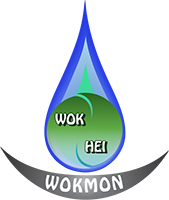 Wok Hei, which is the essence of Chinese stir-frying, is achieved when the center of your wok’s bottom becomes super-hot. However, conventional gas stoves available in the US and most other countries have burners that fan out the flame resulting in a dead spot in the center. Therefore, unlike with Chinese restaurant burners, the wok can never achieve its ultimate cooking potential.
Wok Hei, which is the essence of Chinese stir-frying, is achieved when the center of your wok’s bottom becomes super-hot. However, conventional gas stoves available in the US and most other countries have burners that fan out the flame resulting in a dead spot in the center. Therefore, unlike with Chinese restaurant burners, the wok can never achieve its ultimate cooking potential.
The WokMon’s unique focus ring redirects all gas burner flames towards the center of the burner converting the “dead spot” into a “hot spot” and turning relatively low powered gas burners of a consumer stove into very sufficient wok burners. The results are amazingly hot stir-frying and efficient steaming just like in a real Chinese kitchen. By using every bit of gas flame (measured in BTUs) that would normally be wasted, the “wasted” flame energy is recycled by 50% back towards the center, thus making WokMon a green energy efficient device. [Note: Home gas burners vary from 7000 BTUs to 18,000 BTUs for hi-end stoves versus 150,000+ BTUs for restaurant burners].
Why Such Extreme Temperatures?
Most of the foods we stir release prodigious amounts of water as they begin to cook. The water quenches the heat of the wok until it has evaporated away. An underpowered burner will allow the juices to build up in the pan, and the food will stew rather than stir-fry.
The resulting collection of aromas and tastes bears little resemblance to Wok Hei. This is the reason that domestic burners, or even Western style professional burners, cannot reproduce the flavor of a true wok stir-fry. It’s not your wok: it’s the heat source. America has been stew-frying rather than stir-frying.” – Modernist Cuisine Vol 2, p. 48-57, author – Nathan Myhrvold, 2012 James Beard Award/Cookbook of the Year.
The following videos show the results of WokMon owner James Kao.
These videos were originally posted on YouTube by Mr. Kao.
Regular burner wok heating pattern
WokMon-installed wok heating pattern
with Thermal Imaging
